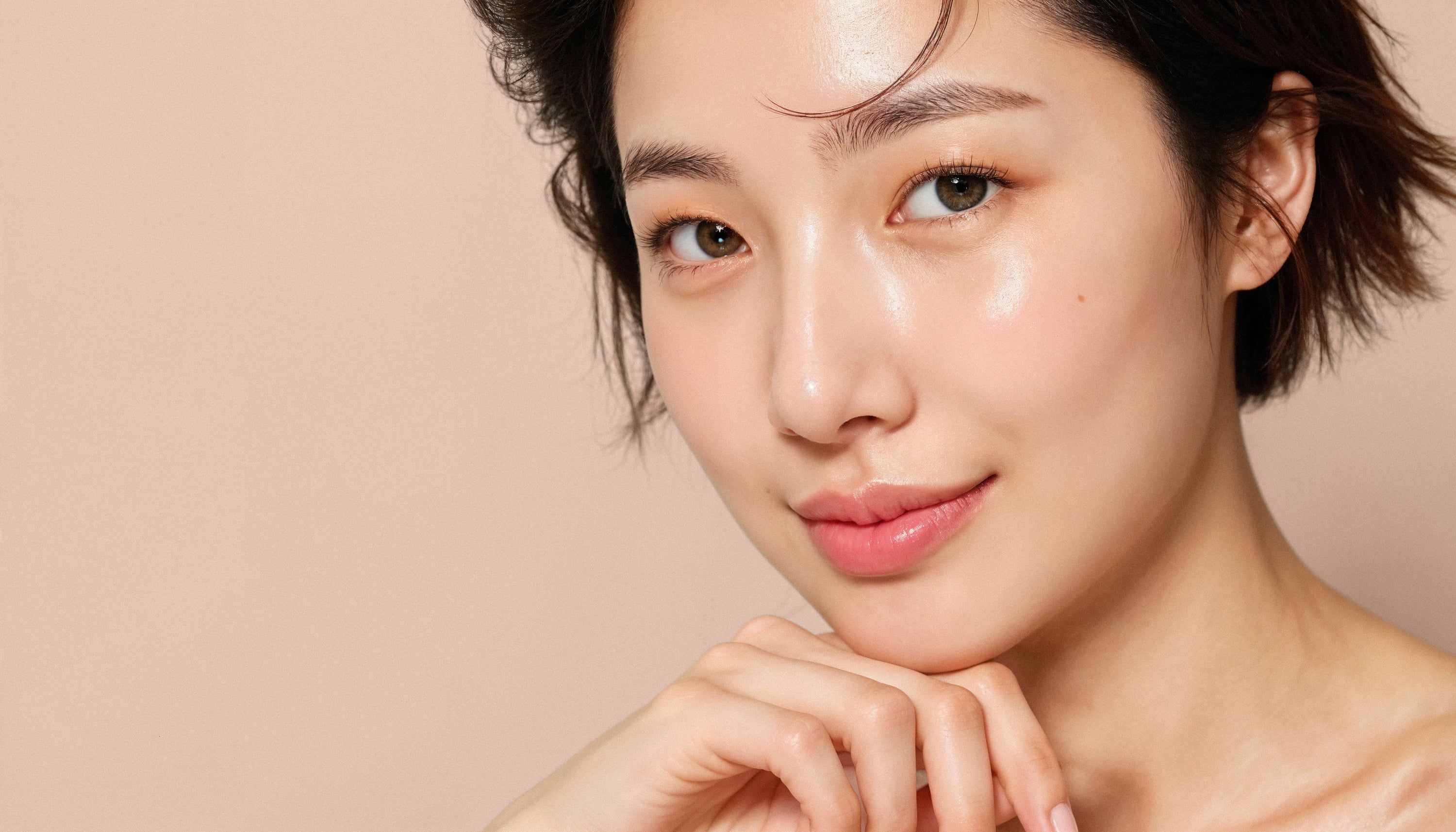In the world of skincare, few trends have captured attention quite like glass skin. It’s the kind of complexion that looks impossibly smooth, poreless, and lit from within — almost reflective, like polished glass. While it might look unattainable, the reality is that glass skin isn’t about perfection or genetics. It’s about skin health, and it’s more achievable than you might think.
Let’s break down where this trend came from, what it really means, and how you can work toward it — no filters required.
What Is Glass Skin, Really?
At its core, glass skin is a reflection of optimal skin condition. It’s deeply hydrated, even-toned, smooth, and has a natural, subtle radiance. The skin appears clear and refined — not because it’s covered in product, but because it’s well cared for.
Glass skin isn’t just about that initial glow after applying a serum. It’s about sustained luminosity — a hydrated, bouncy texture and a translucence that gives skin that “glassy” look, without crossing into oily or shiny territory.
Key characteristics include:
-
Crystal-clear tone with minimal redness or dark spots
-
Supple texture that feels plump and looks smooth
-
Even light reflection across the face — no blotchy shine
-
Poreless appearance, achieved through hydration and barrier care
It’s less about chasing perfection and more about maintaining a consistent, intentional routine that supports skin from the inside out.
Where Did It Start? The K-Beauty Connection
Glass skin first gained traction through K-beauty — a skincare philosophy rooted in prevention, hydration, and long-term results. Unlike Western beauty routines that often emphasize quick fixes or heavy coverage, K-beauty focuses on building healthy skin with gentle, nourishing layers.
As K-pop, Korean dramas, and global access to Korean skincare expanded, so did the influence of these ideals. What was once a local skincare standard became a global aspiration — and for good reason. Glass skin isn’t about transforming your face; it’s about enhancing what you already have.
Is Glass Skin Only for Certain Skin Types or Genetics?
While skin tone, oil production, and pore size are influenced by genetics, glass skin isn’t reserved for a lucky few. In fact, your daily habits matter more than your DNA. Anyone can work toward a glass-like complexion by focusing on hydration, barrier strength, and consistency.
Put simply: your genes might set the stage, but your routine does the heavy lifting.
The Glass Skin Routine: Step-by-Step
If you want that hydrated, reflective finish, you’ll need more than just one great serum. Glass skin requires a layered, thoughtful approach. Here's how to build it:
1. Start with Double Cleansing
Begin with an oil-based cleanser to remove makeup, sunscreen, and excess sebum. Follow with a gentle, water-based cleanser to lift remaining impurities without stripping your skin.
Why it matters:
A clean base ensures that the rest of your products can absorb properly and keeps pores from becoming congested.
What we recommend:
ICD Moisture Cleansing Oil – a gentle yet effective oil cleanser that melts away impurities while nourishing the skin with botanical oils.
Incellderm Snow Enzyme Cleanser EX – a mild, enzyme-powered foam that brightens and smooths while preserving moisture, perfect for sensitive or dull skin.
2. Hydrating Toner or Essence
Apply immediately after cleansing to restore hydration and rebalance pH. Layering (even two or three rounds) is encouraged, especially for dry or dull skin.
Why it matters:
This foundational moisture helps skin stay plump and receptive to other active ingredients.
What we recommend:
ICD Two Phase Oil Mist – a bi-phase mist that combines nourishing plant oils with hydrating botanicals to instantly boost moisture and create a dewy, balanced base.
ICD Calming Balance Gel – a lightweight gel packed with soothing and hydrating ingredients, perfect for calming sensitivity while prepping the skin for next steps.
3. Targeted Serums or Ampoules
Choose based on your skin concerns — niacinamide for pores and tone, hyaluronic acid for hydration, or peptides for firmness.
Why it matters:
These deliver high-impact ingredients exactly where they’re needed, supporting even tone and improved texture.
ICD Dermatology First Package – a best-selling booster and serum combo that delivers deep hydration, revitalizes tired skin, and boosts elasticity.
4. Moisturizer to Seal It All In
Use a moisturizer suited to your skin type, but one that nourishes and strengthens the skin barrier. Look for ceramides, glycerin, and fatty acids.
Why it matters:
A healthy barrier is essential to lock in moisture and maintain that luminous, even surface.
What we recommend:
ICD Dermatology Cream – deeply hydrating with skin-soothing ingredients and a silky finish that locks in glow.
5. Daily SPF (Don’t Skip This)
Apply SPF 30+ every morning. Sun protection preserves all the work you're putting into your skin and prevents hyperpigmentation, dullness, and premature aging.
Why it matters:
UV damage undermines skin clarity and smoothness — the antithesis of glass skin.
What we recommend:
Incellderm Aqua Protection Sunscreen – a lightweight, non-greasy SPF that hydrates as it protects. Formulated to shield skin from UVA/UVB damage while maintaining a smooth, glass-like finish with zero white cast.
6. Gentle Exfoliation (1–3x Weekly)
Use gentle exfoliants to clear dead skin cells and smooth texture. Avoid abrasive scrubs and use a mild exfoliation suitable for sensitive skin types, without the potential irritation that can sometimes be associated with AHAs and BHAs.
Why it matters:
Clear skin reflects light better. Gentle exfoliation keeps skin smooth without compromising the barrier.
What we recommend:
ICD Cleansing Powder Wash – a 2-in-1 cleanser and enzymatic exfoliant that gently refines texture without irritation.
7. Occasional Masks
Use hydrating or brightening masks as a boost a few times a week.
Why it matters: These can help push your routine further, especially when skin looks tired, dull, or dry.
What we recommend:
Incellderm Collagen 100 Melting Sheet – a pure face mask that is made of 100% New Zealand Marine Collagen. It melts into the skin to deliver intense hydration, firming, and a visibly smoother, more luminous finish.
The Glassy Glow vs. Oily Shine: Know the Difference
A common misconception is that glass skin equals shine. But that’s not quite right.
Oily skin often looks patchy, feels heavy, and may come with breakouts. It's caused by excess sebum and can look uneven or greasy.
Glassy skin is smooth, hydrated, and balanced — light reflects off it evenly. It feels comfortable, not sticky, and the glow looks controlled, not accidental.
The difference is in hydration vs. oil — and skin texture plays a big role.
Final Thoughts: It's About Progress, Not Perfection
Glass skin isn’t about unrealistic ideals. It’s about building a skincare routine that works with your skin, not against it — and sticking to it. With the right products, consistent effort, and a little patience, healthy, luminous skin is within reach.
It’s not about looking like someone else. It’s about revealing the best version of your skin — clear, smooth, and naturally radiant.
*Image source: link





